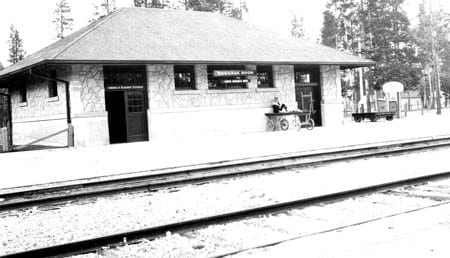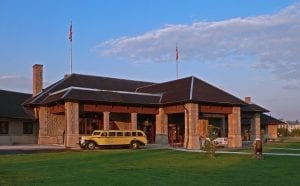
Historic Union Pacific Baggage Building
If any of you have ever taken an extended train trip, you know that you will have baggage. Some of us will have more baggage than others, depending on the length of the trip and our need to carry clothes and accessories with us. On a modern day train trip, you pack a small bag with necessities and keep it with you while your larger luggage is checked by the rail company and put in their baggage car to be retrieved by you at the end of your journey. From there you either take it to your hotel room or, if you are at the end of your journey, you take it home with you.
Rail travelers to Yellowstone National Park had much the same circumstance. When they arrived at the destination in West Yellowstone they had to have a place to store their luggage while they were touring the Park. They could not just leave it on the train.

Union Pacific Depot now hosts the Museum of the Yellowstone
Initially, the East wing of the depot was used to store those bags. However, as train travel to Yellowstone increased the amount of luggage that had to be stored for the passengers increased and the current storage facilities were no longer adequate.
To alleviate the problem the Union Pacific officials, in 1920, proposed the construction of a completely separate baggage building. It was to be located immediately West of the depot. By constructing a separate building to store baggage the company could solve two problems at once. The new building would provide a larger area to store luggage and it would allow them to convert the existing baggage storage space in the east wing of the depot to provide additional changing rooms for their passengers.
The construction was finished by the fall of 1921. At that time there was a change of plans concerning the exterior appearance of the newly constructed facility. This change actually delayed completion of the building until 1922. The exterior walls were quarry-faced stone and it sits on a battered concrete base and has a continuous belt course. The corner quoins are concrete and so are the flat arched window lintels. The exterior dimensions were approximately 32’ x 52’.
When the railroad ceased their operations to the town, the building set empty. Around 1975 the building was renovated and became the town’s police station. The original door and window openings were maintained but were in-filled. The installation of modern metal doors and windows were added in some of the openings. The building probably had a shingle roof but that has been replaced and it now has a standing seam metal roof.
And so, an existing building has a new life.
AUTHOR: SUSIE KNAPP